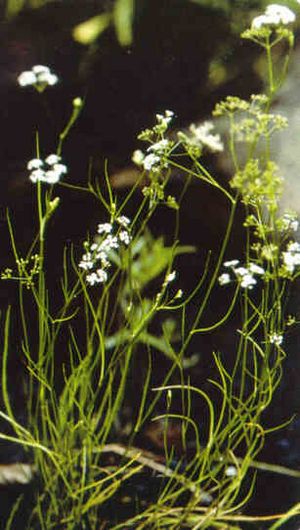Ptilimnium nodosum facts for kids
Ptilimnium nodosum (synonym=Harperella nodosa), often called Harperella or piedmont mock bishopweed, is a special plant. It grows in wet places near rivers and streams in the southeastern United States. This plant is quite rare and is on the endangered species list. This means it needs our help to survive!
Quick facts for kids Harperella |
|
|---|---|
 |
|
| Conservation status | |
| Scientific classification | |
| Kingdom: | |
| (unranked): | |
| (unranked): | |
| (unranked): | |
| Order: | |
| Family: | |
| Genus: | |
| Species: |
P. nodosum
|
| Binomial name | |
| Ptilimnium nodosum Rose (Mathias)
|
|
| Synonyms | |
|
|
Contents
What is Harperella?
Harperella is a small, delicate plant. It has thin stems and leaves that look a bit like parsley. During the summer, it grows tiny white flowers in flat-topped clusters. These clusters look like miniature umbrellas! Harperella belongs to the carrot family, which is called Apiaceae. Its scientific name is Ptilimnium nodosum, but most people call it Harperella.
Where Does Harperella Live?
Harperella is a native plant to the southeastern United States. It likes to grow in very specific places. You can find it along the edges of rivers and streams. It prefers rocky or sandy areas that are sometimes underwater. These areas are called "riparian environments."
Harperella's Home States
This unique plant grows in several states. You can find it in West Virginia and Maryland. It also lives in Alabama and North Carolina. Some populations are found in the Ouachita National Forest. This forest stretches across parts of Arkansas and Oklahoma. Each location is important for the plant's survival.
Why is Harperella Endangered?
Harperella was officially placed on the United States' Endangered Species List in 1988. This means it is at high risk of disappearing forever. There are several reasons why this plant is in trouble.
Habitat Loss
One big problem is habitat loss. The places where Harperella lives are often changed by humans. Building dams can change water levels. Pollution from farms or towns can harm the water. These changes make it hard for Harperella to grow.
Competition from Other Plants
Another challenge for Harperella is competition. Other plants, especially invasive species, can grow faster. They can take up all the sunlight and nutrients. This leaves little for the delicate Harperella.
Small Populations
Harperella often grows in small, separate groups. If one group disappears, it's hard for the plant to spread. This makes it more vulnerable to problems.
How Can We Help Harperella?
Protecting Harperella is very important. When a species goes extinct, it's gone forever. Scientists and conservation groups are working hard to save this plant.
Protecting Its Habitat
One way to help is to protect its natural home. This means keeping rivers and streams clean. It also means managing water levels carefully. Protecting the land around these waterways is key.
Growing New Plants
Sometimes, scientists collect Harperella seeds. They grow new plants in special nurseries. These young plants can then be planted back into safe areas. This helps to increase the number of Harperella plants.
Raising Awareness
Learning about Harperella is also a big help. The more people know about endangered plants, the more they can do. You can tell your friends and family about Harperella. Understanding why it's important helps everyone protect it.


